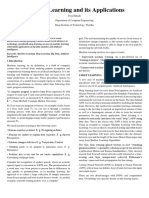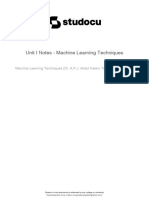0% found this document useful (0 votes)
25 views3 pagesTopic 6 Notes
The document provides an overview of machine learning, focusing on its ability to analyze data, recognize patterns, and make predictions based on past experiences. It covers key concepts such as decision trees, artificial neural networks, and data mining, along with their applications in various fields including pattern recognition and decision support systems. Additionally, it outlines learning objectives and activities related to understanding these concepts.
Uploaded by
LucassiCopyright
© © All Rights Reserved
We take content rights seriously. If you suspect this is your content, claim it here.
Available Formats
Download as DOCX, PDF, TXT or read online on Scribd
0% found this document useful (0 votes)
25 views3 pagesTopic 6 Notes
The document provides an overview of machine learning, focusing on its ability to analyze data, recognize patterns, and make predictions based on past experiences. It covers key concepts such as decision trees, artificial neural networks, and data mining, along with their applications in various fields including pattern recognition and decision support systems. Additionally, it outlines learning objectives and activities related to understanding these concepts.
Uploaded by
LucassiCopyright
© © All Rights Reserved
We take content rights seriously. If you suspect this is your content, claim it here.
Available Formats
Download as DOCX, PDF, TXT or read online on Scribd
/ 3































































































